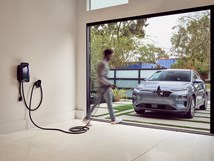Toyota Applies AI to Friendly Concept
Toyota Motor Corp. says its Concept-i car uses artificial intelligence to learn and adapt to driver behaviors, and can communicate information through a mix of lights, sounds and haptic feedback.
Toyota Motor Corp. says its Concept-i car uses artificial intelligence to learn and adapt to driver behaviors, and can communicate information through a mix of lights, sounds and haptic feedback.
The AI system, which Toyota calls “Yui,” is represented by a ring with a smaller circle inside. Instead of using traditional display screens, the icon can be illuminated on various interior surfaces as it moves around the passenger cabin.
Describing the concept as a vision of mobility in 2030, Toyota says the goal of the program is to create a warm, welcoming and fun environment that helps foster a relationship between a vehicle and its occupants. The carmaker used Disney’s 12 principles of animation to help convey feelings and emotions through motion and other techniques. Yui’s appearance can be altered by changing colors and stretching or shrinking its shape. It also can pulse to draw a driver’s attention.
Information is displayed where and when it is needed. Images of objects in traditional blind spots, for example, are projected onto the vehicle’s c-pillars. And colored lights in the foot wells indicate whether the car is operating in normal or autonomous driving mode. A next-generation head-up display projects vehicle information to help drivers keep their eyes on the road.
The exterior door panels light up and greet motorists with messages such as “Hello” and “Welcome Back” as they approach the vehicle. Text warnings (“Watch Out” or “Turning Left”) are shown on organic light emitting diode displays on the front and rear bumpers, while the front fascia signals to other people outside the car whether the vehicle is in a normal or automated driving mode. The headlamps are invisible when the vehicle is turned off and wink as people approach.
Toyota says the car uses AI to learn about driving patterns, schedules and frequent destinations. Motorists can choose between automated and manual driving modes. In automated mode, drivers may be prompted to take control if needed or alerted to stay attentive. Conversely, driver assist systems will automatically take control to help avoid or lessen the impact of an impending accident.
Engineers and designers developed the vehicle at Toyota’s Calty Research Center in Newport Beach, Calif., with user experience input from the Toyota Innovation Hub in San Francisco. The carmaker plans to test aspects of the car this year in Japan but has no plans to produce it.
RELATED CONTENT
-
Jeeps Modified for Moab
On Easter morning in Moab, Utah, when the population of that exceedingly-hard-to-get-to town in one of the most beautiful settings on Earth has more than doubled, some people won’t be hunting for Easter eggs, but will be trying to get a good look at one of the vehicles six that Jeep has prepared for real-life, fast-feedback from the assembled at the annual Easter Jeep Safari.
-
GM Develops a New Electrical Platform
GM engineers create a better electrical architecture that can handle the ever-increasing needs of vehicle systems
-
Cobots: 14 Things You Need to Know
What jobs do cobots do well? How is a cobot programmed? What’s the ROI? We asked these questions and more to four of the leading suppliers of cobots.








